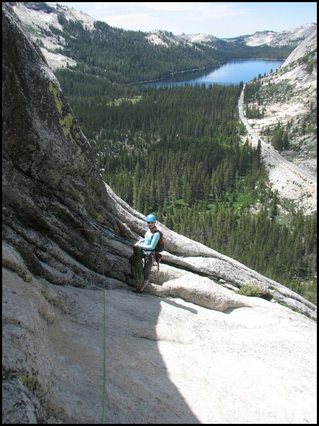 Yosemite National Park. The best granite climbing in the world. The Tuolumne region of
YNP
is famous for its giant granite domes: Stately Pleasure Dome, Lembert Dome, Fairview Dome, and Pywiack Dome. One of our favorite multi-pitch climbs in Tuolumne is
Zee Tree
on Pywiack Dome. We've completed this ascent together multiple times. It's a good introduction to multi-pitch climbing as the overall rating is only 5.7.
Yosemite National Park. The best granite climbing in the world. The Tuolumne region of
YNP
is famous for its giant granite domes: Stately Pleasure Dome, Lembert Dome, Fairview Dome, and Pywiack Dome. One of our favorite multi-pitch climbs in Tuolumne is
Zee Tree
on Pywiack Dome. We've completed this ascent together multiple times. It's a good introduction to multi-pitch climbing as the overall rating is only 5.7.
On multi-pitch, bolted routes like
Zee Tree
, permanent belay stations are located every 50 to 100 feet (the length of a single pitch); these consist of heavy bolts screwed into the face of the rock. Climbing works best in teams of two moving inchworm-style: Climber One is tied into the front of the rope and leads the climb, placing protection on his way, and fixes the anchor at the top; Climber Two follows once the anchor is set, cleaning the route by removing the protection, and arrives in time to belay Climber One on his next pitch.
The second climber in the team is better protected. While the "leader" (Jonathan, in our case) brings the rope up behind him, relying on the placement of gear to protect him in the event of a fall, I follow once an anchor has been built above me. If I fall, Jonathan's belay will have me within a few inches. If Jonathan slips on his climb, he will fall twice the distance between his feet and last piece of protection in the rock before my belay catches him from below.
Above: Six pitches of slab will challenge both your physical and mental stamina, but the wide-open exposure has its perks. The view southwest to Tenaya Lake is a breathtaking sweep of emerald green and piercing blue.
Objective:
Zee Tree (5.7)
Style:
Sport Climbing/Trad Climbing (final pitch)
Level:
Easy/Moderate
Length:
700 feet, 6 pitches, 3 hours
Approach:
Drive up and park on Hwy 120. (Winter closures.)
Though not quite the easy approach offered by neighboring Stately Pleasure Dome, the approach for
Pywiack Dome
does include quick-access parking at pullouts along Highway 120. From there, you'll walk down into a ravine, cross a small stream (size dependent on the time of year), and then scramble up some scree before you reach the base. Finding the first set of bolts can be a challenge. If you arrive and see other climbers on the wall, use them as a guide. You'll be walking up to the first set of bolts unprotected. If you're a new climber, this can seem daunting. Remember, if there is a more experienced climber in your group, he or she can walk up and fix an anchor, then lower a rope for less experienced climbers to tie into.
Make sure to
check supertopo for route beta
before you start out.
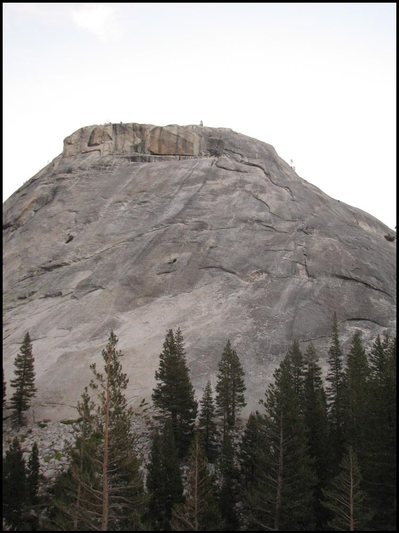
Above: This end of Pywiack Dome hosts multiple routes:
Piece of Grass
(5.10d),
Needle Spoon
(5.10a),
Dike Route
(5.9),
House Calls
(5.6), in addition to
Zee Tree
(5.7).
It's a good idea to
invest in a guidebook specific to Tuolumne
(and/or research the climbs online)
before setting out so that you don't wind up on the wrong one.
In the photo below, you'll get a better idea of the approach to the base of the wall. Our car is one of the two parked in the pull-out. I'm at the top of the second pitch, tied in and belaying Jonathan. It's important to communicate with your partner when you need a rest at belay stations. Belaying requires intense focus, even on simple slab routes like
Zee Tree
. If you're tired or your ankles hurt, clip in to the station securely and take a breather before you begin belaying.
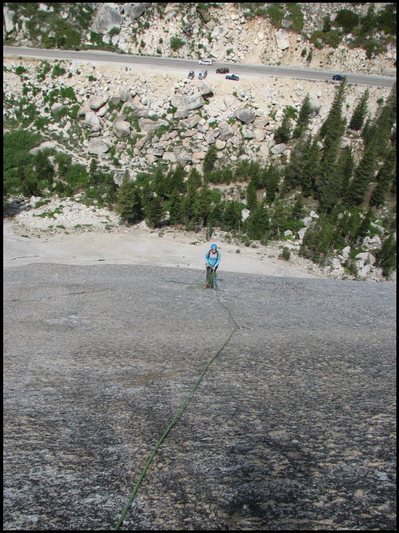
Above: At the top of the second pitch, belaying Jonathan. My ankles are fine here, but give me another
pitch or two, and they'll be burning under the strain of holding myself at that angle. Take breaks before
your partner begins to climb. There's no breaking once he/she is on her way up the next pitch.
A couple of the pitches on
Zee Tree
are long (
runout
). Experienced climbers won't have much difficulty with the length, but the rest of us just have to learn to breathe through it. The granite slab undulates enough that you won't be able to see your climbing partner the whole time. Trust your shoes. Trust the rope. Remember that, if you slip, your partner's belay will have you quickly, but the rope isn't static. Climbing ropes stretch! My first big slip happened on
Zee Tree
. Because the rope was snagged on a wave of granite, there was some excess slack. I stumbled down and back a few feet before the rope caught me, and even then it stretched several feet more. The whole thing felt scarier than it was. Bottom line: Communicate, double check everything before you begin, then trust yourself.
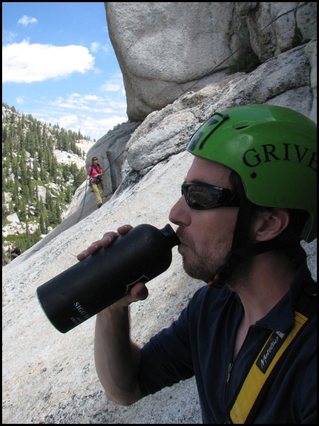

Left: Water break at the top of the 4th pitch before making the traverse to the bottom of the last pitch.
The climbing world is a small one after all. B
ehind Jonathan you can see a friend of ours. We bumped
into
her that day a
s she made another Pywiack Dome climb with her daughter and a friend.
Right: Chillin'. Pretty sweet view.
After you traverse from the top of the 5th pitch to the bottom of the final pitch, you'll come to the toughest part of the climb (also known as the
crux
of the route). This is a wide, vertical crack. Unlike the rest of the route (sport climbing), this crack climb requires the placement of your own gear (trad climbing). While this pitch is no more technically difficult than the rest of the climb, transitioning from forward-leaning and toe smearing to lying back on a crack is a major mental switch, especially once you're up so high!


Left: The final pitch, a wide, vertical crack. This is the view from the top of the 5th pitch.
Right: And here's how it looks once you've made the traverse and you're at the base.
Crack climbing is fun! It's tough to practice in the gym because few gyms have good cracks built into their walls; and when you do find a crack in a gym, it usually has a static rating (and the rating is often difficult, so beginning climbers are out of luck). I've gotten myself into all kinds of fun, desperate positions on this particular crack. I lack the upper body strength Jonathan has, so it's less about muscle for me. Instead, I treat it as a puzzle.
Don't be afraid to use your shoulders, your knees, your face. Okay, don't use your face. But remember that climbing is a full-body sport. Lock your fingers around the edge, lock your arms straight, and try to walk up. If that doesn't work, you're not out of luck. Use a
fist-jam
. When you find a spot where you can rest, take it. This will either be your favorite part or your least favorite part of the climb.
And then you're up, over, out, and ready to celebrate! Don't be surprised if your climber's high leads to some of the following behaviors:
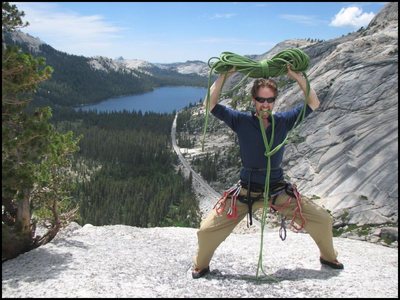

Now, unlike single-pitch climbs, where you usually wind up where you began, multi-pitch climbs require that you have an exit route. Climbing guides will detail this for you. There are a few different ways off Pywiack Dome, and most of them involve rappelling. If you rappel off the back of the dome, you'll end up walking westward toward Tenaya Lake and back to the road.

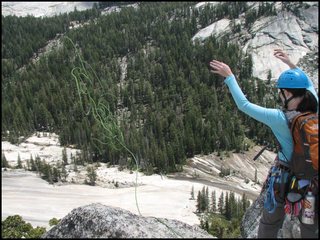

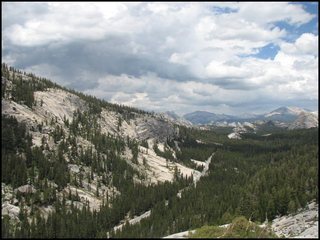
Clockwise from Top Left: Found our rappel spot! Time to throw the rope! (This is my favorite part.);
Heave- ho!; Not far to go now.; Looking eastward toward Tuolumne Meadow.
Hiking out from the backside of the dome reveals some amazing, unobstructed views of
Cathedral Peak
. We've been to the top of that one, too. Jonathan even climbed the pinnacle with some guys.

Above: Unobstructed view of Cathedral Peak.
If you're preparing for your first multi-pitch climb, remember to bring lots of water, read your guide books carefully beforehand, double check that you have all necessary gear before you start, take breaks when you need them, and don't forget your camera. Have fun!
A PDF download including info on
Zee Tree
can be found
here at gearlooptopo.com
.
